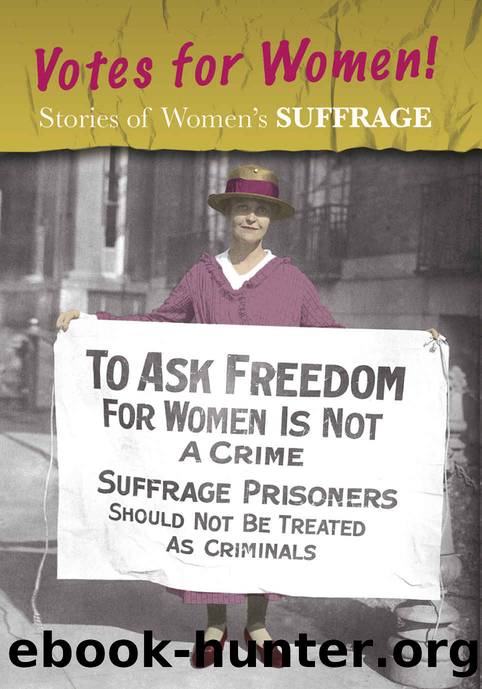Stories of Women's Suffrage (Women's Stories from History) by Charlotte Guillain

Author:Charlotte Guillain [Guillain, Charlotte]
Language: eng
Format: azw3
Publisher: Heinemann
Published: 2015-01-31T16:00:00+00:00
Carrie Chapman Catt: “The woman’s hour has struck”
Just a few years after Clementina Black was born in the United Kingdom, another future leader of the women’s movement was born in the United States—Carrie Chapman Catt. Working with Susan B. Anthony and other leaders in the suffrage movement, she continued where older leaders had left off and helped make the long-awaited 19th Amendment a reality.
Carrie Clinton Lane was born in Ripon, Wisconsin, in 1859 and moved to Charles City, Iowa, when she was seven. She noticed at an early age how unfair life was for women. At age 13, she felt outraged when she discovered that her mother was not allowed to vote in the presidential election, but her father was.
Her parents were farmers and held the very traditional views of the time. Her father did not want her to go to college and refused to support her, so Carrie taught at a school to save the money she would need to go to college. She paid her own way through her studies by washing dishes and working in the library.
While she was a student, Carrie got involved in public speaking, which was very unusual for female students at the time. She even organized a debate on women’s right to vote, long before many of her fellow students had even started to consider the issue. Carrie was both the valedictorian (top student) and the only woman in her graduating class at what is now called Iowa State.
Carrie went on to study law. Then, she became a teacher and was the first female superintendent of schools in her district. These roles helped her to become a very good leader and organizer of people.
In 1885, Carrie married Leo Chapman, the editor of a newspaper. After their marriage, Carrie began working with him and soon became coeditor of the newspaper. She introduced a new section to the newspaper called “Woman’s World.” This gave her the opportunity to spread her ideas about women’s rights to a wide readership.
Then she joined the Iowa Woman Suffrage Association, starting to get involved in the debate about women’s rights at a national level.
Sadly, her husband Leo died just a few years after they married, and so Carrie worked alone as a reporter and a lecturer to support herself. She was eager to find other women who also wanted to win the vote and decided to make this the focus of her work.
She became a leader of her local campaigning organization, the Iowa Woman Suffrage Association, in 1889. The following year, Carrie married George Catt, a wealthy engineer who supported Carrie’s views. He agreed she should spend several months each year campaigning for women’s right to vote.
George sometimes spoke in support of women’s suffrage at meetings himself, and his financial backing made it much easier for Carrie to fight for her beliefs. She said, “We made a team to work for the cause.”
Carrie was very good at organizing campaigns and rallies, but initially she felt frustrated that she did not seem to be able to make any impact.
Download
This site does not store any files on its server. We only index and link to content provided by other sites. Please contact the content providers to delete copyright contents if any and email us, we'll remove relevant links or contents immediately.
Pale Blue Dot by Carl Sagan(3997)
Bloody Times by James L. Swanson(3977)
I'm Still Scared by Tomie dePaola(3910)
Pocahontas by Joseph Bruchac(3720)
Little Author in the Big Woods by Yona Zeldis McDonough(3123)
Seriously... I'm Kidding by Ellen DeGeneres(3098)
Earthrise by Edgar Mitchell(2757)
The Science Book (Big Ideas Simply Explained) by DK(2741)
The President Has Been Shot!": The Assassination of John F. Kennedy by Swanson James L(2731)
Hello, America by Livia Bitton-Jackson(2720)
The Extraordinary Suzy Wright by Teri Kanefield(2344)
Ben Franklin's Almanac by Candace Fleming(2050)
Brown Girl Dreaming by Jacqueline Woodson(2016)
Cleopatra: A Life by Stacy Schiff(1931)
Birds, Beasts and Relatives by Gerald Durrell(1858)
The Audition by Maddie Ziegler(1809)
I Will Always Write Back by Martin Ganda(1762)
Bloody Times: The Funeral of Abraham Lincoln and the Manhunt for Jefferson Davis by James L. Swanson(1723)
The Complete Adventures of Curious George by H. A. Rey(1687)
